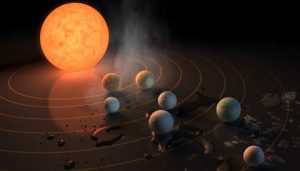The star with seven exoplanets puts out enough high-energy radiation to tear away the inner planets’ atmospheres in a few billion years.

© Franck Selsis / Laboratoire d'astrophysique de Bordeaux (CNRS / Université de Bordeaux)
The world is abuzz over the little star TRAPPIST-1, the ultracool M dwarf with seven potentially rocky exoplanets. The buzz started in 2016, when astronomers first discovered a couple of small worlds orbiting the star. As part of the ongoing — and now fervent — interest in this pipsqueak sun, Vincent Bourrier (University of Geneva Observatory, Switzerland) and colleagues are putting together a picture of how much high-energy radiation streams out from the star, and what that radiation might mean for the planets.
The team used the Hubble Space Telescope to study the star’s ultraviolet output. Specifically, they looked at Lyman-alpha emission, which is a particular wavelength emitted by hydrogen atoms and comes from the star’s chromosphere, the layer between the stellar “surface” (the photosphere) and the intensely hot, ionized, wispy corona.
The team found that TRAPPIST-1 emits less than half as much Lyman-alpha radiation as other cool, exoplanet-hosting M dwarfs — including Proxima Centauri, which spews forth six times more in ultraviolet as TRAPPIST-1 does. That’s to be expected, since TRAPPIST-1 is also cooler than the other M dwarfs are.
However, last year the team also found that TRAPPIST-1 emits about as much in X-rays as Proxima Centauri. These X-rays come from the stars’ coronas.
The ratio of X-rays to ultraviolet is interesting for a couple of reasons. First, X-ray and ultraviolet output decrease with time for these stars, but X-rays drop off much faster. The fact that TRAPPIST-1 emits roughly a third as much energy in Lyman-alpha as it does in X-ray suggests that the star is “relatively young,” the team posits in their March 2017 Astronomy & Astrophysics article.
What “relatively young” means is an open question. Astronomers know the star is at least 500 million years old, because it’s “settled” into being an adult star. Beyond that, it’s anyone’s guess. Jeffrey Linsky (University of Colorado, Boulder), who has worked extensively on M dwarfs and the trends in Lyman-alpha and X-ray emission for different types of stars, says that TRAPPIST-1 seems both old and young. Stars are born spinning quickly, then slow as they age. TRAPPIST-1 whips around every 1½ days, which at face value would point to it being young, he says — but astronomers don’t know how fast these ultracool dwarfs spin down. Furthermore, the star’s fast motion through space usually would indicate it’s a member of the old stellar population that comprises the galaxy’s halo, but goodness knows if that’s a fluke.
Bourrier agrees that the age question is currently unanswerable. The ratio of X-ray to ultraviolet emission seems to indicate that TRAPPIST-1 is “not extremely old,” he says, “but I do not think that at this point we can say much more than this.”

Credit:
NASA / R. Hurt / T. Pyle
The second reason the X-ray and ultraviolet levels matter is for habitability, a possibility which has received perhaps more attention than it deserves. Although the ultraviolet level is low, the radiation overall is still high enough that it could strip an Earth-like atmosphere from the inner two planets, b and c, in 1 to 3 billion years; for the planets d, e, f, and g (e, f, and g are in the putative habitable zone), the process would take anywhere from 5 to 22 billion years. The team does see a hint of atmospheric escape from b and c, although the slight drop in starlight that implies it might instead be due to coronal variability.
Due to the worlds’ methodical spacing, astronomers conclude the planets likely migrated to their current orbits from farther out. But we don’t know how long ago that happened, or whether the orbits are stable long term. “If they migrated within a disk, typical time scales are about 100 million years, but that may not be valid for a system like TRAPPIST-1,” Bourrier cautions. “Uncharted territory here!”
Reference:
V. Bourrier et al. “Reconnaissance of the TRAPPIST-1 exoplanet system in the Lyman-alpha line.” Astronomy & Astrophysics. March 2017.
Daydream about booking your vacation to TRAPPIST-1 with NASA’s Visions of the Future poster.
 5
5









Comments
March 6, 2017 at 9:34 am
It sounds to me like they have more questions than answers at this point. It's nice to know which stars have planets and which don't, but it seems to me if astronomers want to find a world like earth, they should concentrate their efforts on sun like stars. Those red dwarfs are too cool and they give off a lot of radiation. The planets have to be too close to them to be in the goldilocks zone. And it seems they are tidally locked. It's interesting, though, to know there are so many out there. God has filled the universe with galaxies, stars, nebulae, and planets. It all shows the glory of God.( Psalm 19:1)
You must be logged in to post a comment.
Capella80
March 8, 2017 at 6:56 pm
Have they found any planets around Alpha Centarui, Alpha Centauri?
You must be logged in to post a comment.
jag217
March 16, 2017 at 3:50 pm
Nonsense. Like the zodiac and creatures of the constellations gods are mythical. Purely the invention of humanities' collective imagination. Save the fiction for fiction sites.
You must be logged in to post a comment.
Anthony Barreiro
March 6, 2017 at 3:21 pm
" ... habitability, a possibility which has received perhaps more attention than it deserves."
Well said. There is a lot of work to do to characterize the TRAPPIST-1 system on its own terms, before we could start looking for ET there.
You must be logged in to post a comment.
Rhinochuckles
March 27, 2017 at 1:41 pm
Reminiscent of the Galilean satellites around Jupiter, only closer together. Wondering if the inner planets in the TRAPPIST-1 system also experience tidal heating like Io does sufficient to expel all volatiles?
You must be logged in to post a comment.
You must be logged in to post a comment.